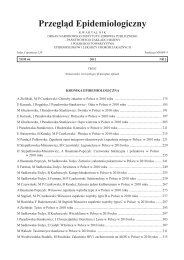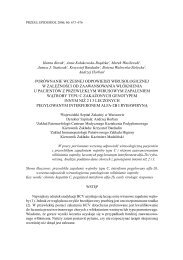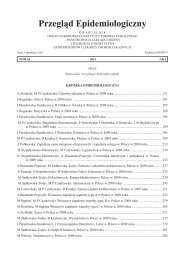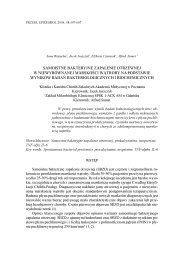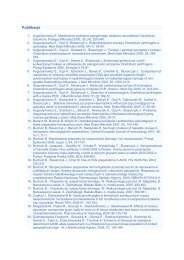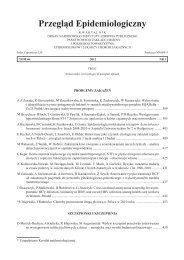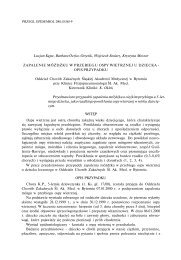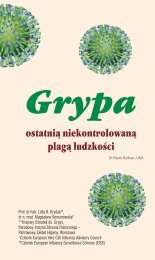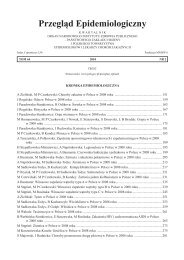Przegląd Epidemiologiczny - Państwowy Zakład Higieny
Przegląd Epidemiologiczny - Państwowy Zakład Higieny
Przegląd Epidemiologiczny - Państwowy Zakład Higieny
You also want an ePaper? Increase the reach of your titles
YUMPU automatically turns print PDFs into web optimized ePapers that Google loves.
158 Joanna Woźniak-Holecka, Mateusz Grajek i inniNr 12009 was about to reach 6.9 billion PLN. To comparein year 2006 market value was 5.7 billion PLN, whichcorresponds to 33% pharmaceutical market value (2)).Governments’ Health Care Policy fundamental role isto support and broaden health knowledge in society,also in terms of self-cure. This is to relieve Health CareSystem services form basic and simple preventive andtherapeutic actions. Thanks to that patient responsiblefor his health, begins the treatment when concernedby the symptoms. However, there emerges a questionwhether an average person’s knowledge is sufficientenough to start a treatment without consulting it with adoctor. Is a pharmacist’s advice within so called pharmaceuticalcare, often marginally treated by pharmacistthemselves enough? This study is an attempt to answerthis question.The purpose of the conducted research was toevaluate knowledge of people from medical and non--medical environment (students and staff) about OTCdrugs usage. Factors like educational and occupationalbackground of people using these drugs were taken intoconsideration. The research was to find answers to threebasic research questions:• Does education, income and occupation influencebuying and using OTC drugs?• Do respondents from medical sector have betterknowledge on OTC drugs?• Which OTC drug type is most frequently purchasedand used?MATERIAL AND METHODSDuring the project an anonymous questionnaire washeld. Survey was carried out using randomly selectedrespondents. Author’s questionnaire was used duringthe project. The questionnaire consisted of 47 closedquestions, open questions and half-open questions (7questions concerning respondent’s data and 40 detailedquestions concerning purchasing and using OTCdrugs). The survey was held on a group of 400 peopleliving in Silesia, who constituted 4 separate groups (100people each):• Medical students (from Medical University of Silesiain Katowice): Medicine (19 people), Pharmacy (24people), Medical Analysis (19 people), Public Health(38 people).• Non-medical students (from University of Silesiain Katowice and University of Economics in Katowice):Science (Biology, Environmental Protection,Chemistry, Physics, Geography, etc. – total of 46people), Humanities (Philology, Law, Human ResourceManagement, Social Policy, etc. – total of54 people).• Medical staff: nurses from the hospital ward (50people), from the operating unit (33 people) or otherpositions (17 people).• Non-medical staff: people professionally not connectedwith medicine include: miners, shop assistants,waitresses, etc.The questioned people were chosen by independentdrawing. Entry criteria included students and workingpeople. Exclusion criteria included unemployed andnot studying people. There were 67% of women (269people) and 33% of men (131 people). Majority ofrespondents were people aged 20-29 and people withsecondary education. MS Office Excel was used to developdatabases presented in the paper. Data from theconducted questionnaire were coded as qualitative variablesmeasured on nominal scale. Statistical analysiswas performed with StatSoft Statistica 8 package bymeans of the χ 2 test for qualitative characteristics (wherethe adopted level of significance equals to p



